|
10. THE BLOOD OF LIFE
There may be another way of looking at the Crucifixion, and hence,
another way of resolving the contradiction of these terms. One
possible explanation for the use of the two different words, soma
and ptoma, to describe Jesus’ body is that the Gospel writers were
expert word workers. They understood that words have history and
multiple levels of meaning. They treated words similar to the way a
geologist treats a core sample of soil.
More profoundly they also understood that many words have secret
meanings hidden beneath their surface. As the book of Daniel states,
“for the words are to remain secret and sealed until the time of the
end.” 1
The Gospel writers frequently used words with double meanings to
describe the same thing. This enabled them to conceal the true
meaning of their words while at the same time telling those ‘in the
know‘ exactly what they meant. They did this to escape persecution
by opposing religious and political authorities, and also to
communicate ala Winston Churchill and F.D.R., between themselves.
The word soma is not an original Hebrew, Greek or Latin word.
Precedent for this word is found in the Hindu Vedas where soma
refers to “the blood of life” and “a mystical substance of the
body.” 2
The Greeks applied it to the “supernatural red wine“ of the Greek
mother goddess Hera, who gave the Greek gods immortality. Saxons
worshipped her at Heresburg (Hera’s Mount), where the phallic
“column of the world” called Hermeseul (Herme’s Soul or Stone Soul)
was planted in the Earth-goddess’s yoni (womb).3
In their word play the Gospel writers are therefore hinting that
Joseph was asking for the literal blood of the hare, Christ, or
alternatively, some form of life-prolonging wisdom which enabled one
to transform the vibration of their own blood into such a state.
The hare provides a link between Osiris “the Good Hare,” and the
secrets of the Crucifixion revealed on the first Easter Sunday, now
symbolized by a rabbit. In addition, the Chinese H-Sien alchemists
were among those who are believed to have found the elixir of life
and transformed themselves into material but immortal ‘light’
beings.4 Their secrets of immortality were also symbolized by the
hare.
Being immortal and confined to Earth might not be a lot of fun. The
myths of the hare’s hole in space we have examined and the
connections we have made between the hare and stories featuring interdimenstional travel indicate that the rabbit’s hole of myth was
actually a wormhole or stargate. The transformation into a shining
being of light undergone by the H-Siens and others indicates that it
was a necessary preparation for travelling via these stargates.
Simply, one would not just enter one of these gateways. There is a
profound spiritual and technical transformation that must be
undergone first.
Further, these connections enable us to view the Crucifixion of
Christ as a stargate event in which the hare, Jesus, demonstrated
how to blast through the rabbit hole opened by the Pillar of the
Goddess Hare or Hara. Joseph of Arimathea was ready for the result
of this A-tomic process.
Once apprehended, the Bible affirms this view in its version of the
Crucifixion.
THE CROWN OF THE WORLD
The Gospels go to great pains to document that Jesus was made to
wear a crown of thorns and a royal purple robe enroute to the
Crucifixion.5 The stargate theory in which Jesus travels into the
A~tum or a~tom explains why was attired in this manner.
Jesus was called the Nazarene. This has been thought to refer to
Nazareth, the town where Jesus is alleged to have lived. Bethlehem,
Nazareth and Galilee all claim to be the home of Jesus. Scholars now
claim, however, that the town of Nazareth did not exist at the time
of Jesus.
Therefore, Nazarene must refer to something else. As we have noted,
names and words mean different things at different times in history.
Drilling to the depths of the meaning of the word “Nazorean” or
“Nazarene” holds the means to decipher the meaning of Jesus’ robe
and crown of thorns and their use in the opening of the stargate.
As we have seen, Nazorean has been interpreted in multiple ways.
Historian Michael Grant interprets Nazoraios as “guardian,” and says
it comes from the root netser, meaning “shoot” or “branch” (klone in
Latin).6
Jesus was known as the branch of David, the long-awaited Messiah.
Grant identifies Jesus as a member of an exclusive religious sect of
priest-kings who guarded or “watched” the secrets of the ancient
science of salvation and enlightenment. This group inherited this
role from Egypt and
the ancient Neter (also rendered as
nuter or Nu),7
meaning “one who watches.” 8
The Neter were the male god-beings of Egypt. Nu-trit, “nurturer,”
was the feminine for neter.9
Budge notes that neter was a term used
to denote a quality of soul.10
As it is mentioned in opposition to “the dead,” he says, it appears
to refer to a “living” or “strong” soul.11
These terms align with the thesis that Lord Melchizedek (E.A)
initiated a Grail bloodline to preserve the secrets of
enlightenment. In order to access these secrets, which were
symbolized by the H, one had to be born into the bloodline or
transform the rhythm or vibration of one’s blood to match that of
the Neter. Jesus (sometimes called Jesus H. Christ) was a descendent
of the bloodline of Abraham, who first received this H, as well as
of David and Aaron, the magician-priest and brother of Moses.
As the Nazarene, Jesus was therefore, a Neter or NTR, or protector
of knowledge. In the
Book of the Dead neter is mentioned in
connection to eternal existence and self-production, which Budge
links to the power to “renew life indefinitely.”12
In other words, he says, neter appears to refer to a being who has
the power to generate life. The word neter passed over directly into
the Coptic language as nouti and noute, both terms meaning “God
” and
“Lord.”13
Both terms were applied to Jesus. The secret knowledge I propose
Jesus possessed and protected was the nuclear secrets of the
transformation of the human being into a neter preparatory to
travelling to Neter-Neter land, the home of the gods, and of
Neter
netri, the secrets of “self-produced, primeval matter.”14
These guardians were known for their trademark, untrimmed hair.
Legend claimed there was great power in their hair. Later, the word
kaisear (later caesar and czar), meaning “crown of hair” was adopted
to describe these guardians.15
In the Bird Language, the “crown of hair” is a phonetic word play
linking it with the “crown of the hare,” or the crown of the goddess
Hara. Another name for this crown is the Shugurra helmet of the
goddess Mari (also known as Hara), which enabled her to “go far into
the universe.”
As the Bible records, Jesus wearing of the Crown of (T)horns at the
Crucifixion had the same effect. The harlot or harelot, priestess of
Hara, Mary Magdalene undoubtedly knew true meaning of this Crown.
Christ’s Crown of Thorns, woven it is said from acacia, the same
living wood as Osiris’ palladium Pillar and the Ark of the Covenant,
is a solar crown.
As in the case of the goddess Mari, this crown was worn in
conjunction with the Pillar, which I have noted, resembles a Van de Graaf generator or
a~tom smasher. Did it open a gateway into the
primordial inner matter or world of the a~tom?
SABA
On closer inspection, the Crucifixion story is loaded with words
with deep scientific connections that substantiate my A~tomic
Christ/stargate thesis.
In Matthew Jesus uttered Eli, Eli, lama Saba Chtoni, (My Lord, my
Lord why has thou foresaken me?),16 just before giving up the
spirit.
The word Sa Ba catches our attention. This is not an original Hebrew
word. We have already seen it used in the name Sabala, from the
Central Asian myth of Mount Meru and
Shambhala. When we drill into
the meanings of this word we discover that in ancient Egyptian Sa is
the word for the holy blood of Isis. Like its counterpart the Hindu
soma it made pharaohs immortal.17 This blood contained the Great
Mother’s spirit of all sacred wisdom or intelligence (which the
Greeks called nous).18
Ba means soul.
During his sa-crifice Jesus ‘gave up the spirit’, one of the few
Crucifixion events which all four Gospel writers agree happened.19
His uttering of Psalm 22 indicates this may have been a reference to
his relinquishing the Sa Ba, “the spirit or soul of all sacred
wisdom.”
Fascinatingly, the origin of the word sacrifice supports this
supposition. Sacrifice comes from sacer, sacred, and facere, to
make, and means “the offering of anything to a deity as homage.”
20
Facer means “one who is impudent or brazen.”21
In the Bible “the one who is brazen” is the healing serpent hoisted
upon a pillar by Moses.22
This ‘worm’ or serpent-soul is the object Joseph sought when he asked
for the soma, which also means holy blood of the goddess, and is
called Saba in Egypt. This worm is the serpent-soul of divine Wisdom.
Based upon our study of the uraeus of the pharaohs and the
theosophical practice of clairvoyant microscopy, we may speculate
that this worm projected itself out of Jesus’ forehead and into the
depths of the a~tom.
THE DOOR OF WISDOM
Another viewpoint concerning this dead/live body or blood of life
question arises from the fact that the word “cross” did not appear
in the Bible until after 500 AD.23 This explains why the “Latin”
(Roman) or “Passion” cross, the primary icon or logo of
Christianity, did not appear in Christian art until 600 AD either.24
In the original Greek version of the New Testament the word used for
the Pillar upon which Jesus was Crucified was Stau-ros.
As we have seen, in Egypt tau was another name for the ankh, the
Cross of Life. Ros means wisdom and dew. Amalgamating these word
meanings, renders Stau-ros as “the Pillar or Cross of Life or
Wisdom,” perfectly aligning it with the concept of the Saba, the
Egyptian term for the ‘blood of life’, and soma, the Greek and Hindu
soma as the blood of life or wisdom.
The lower section of the ankh or Key of Life is a cross. More
interestingly, the Key of Life was made from a branch from the Tree
of Life that grew in the Garden of Eden. The Church claimed the True
Cross was also made of the same wood that grew as the Tree of Life
in Eden.25 Like the Key of Life, Adam conveniently passed the cross
along his bloodline for the express purpose of crucifying the Savior
(who in this case would be the a~tom) whenever or wherever he
appeared.
The Egyptian name for the Tree of Life, we have seen, was the Djed
pillar, a ladder to heaven, sacred to Osiris and Horus, the Egyptian
‘savior’ figure. This ‘ladder’ is a symbol of that which must be
ascended in order to reach Anu in Tula, the core Sun behind the sun,
behind A~tum. It was described as the ladder by which souls of the
dead made their way to the Fields of Peace (which, coincidentally,
were always said to lie to the north, the same direction as Tula.)
In the Pyramid Texts, in which the pharaoh’s journey to immortality
is described, the two TET pillars are shown on either side of the
“Door of Heaven.” The doors remain sealed until the pharaoh utters
the word of power. Then, suddenly, the “double doors of heaven open
up… the aperture of the celestial windows is open.” And soaring as a
great bird, the pharaoh’s Ka has reached the land of the living.

In this depiction drawn by a savant in Napoleon’s army from the
Temple of H-orus at Edfu in Egypt,
fourteen steps on an ascending
stairway lead
to a pillar topped by a crescent moon cradling the eye
of A~tum.
This ceremony is supervised or conducted by Thoth
who
stands on a line that leads into his moon sky-boat or Ark behind
him.
The Crown of Thorns and the Stau-ros Pillar also aligns the
Crucifixion with the Great Pyramid complex in Egypt. The ancient
Egyptians called this complex the Ros-tau,26 the mirror image of
Stau-ros. The Giza-Rostau complex was at the end of the ‘sacred road
of the neters,’ suggesting it was a passageway used by the gods to
enter the Tuat or underworld. Jesus may have been the last of their
kind. It appears he was not the first to use this Pillar to create
an exit portal from Earth.
The ladder concept appears in between the time of Horus and Jesus in
the story in which Jacob ascended a Ladder to Heaven. An important
Sumerian myth of Anu interpreted by Sitchin describes a similar
device with an identical result.27
In a morning-time ceremony in which Anu departs Earth, Enki and
Enlil, two sons of Anu, await Anu at what is called the “golden
supporter.” They hold several objects: “that which opens up the
secrets“ (most certainly the Key of Life, which was used as the
‘remote control‘ for the Tree of Life), “the Sun disks,” and the
“splendid shining posts.”
The “golden supporter” device is sheathed in a golden skin.
Anu and his wife, Antu, stand before the golden supporter, which can
only be the golden needle, the Pillar or Tree of Life. The device
comes alive, the gate swings open and Anu and Antu enter the Abyss
(sometimes called the Fish of Isis).
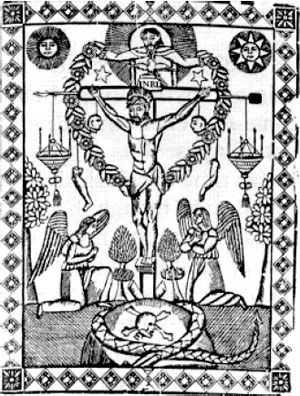
The Crucifixion of Jesus.
Two people were known to flank this third
person who stands upon a cross, a gateway.
The sun and moon symbols
can be seen above him.
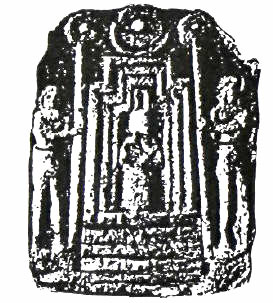
Incredibly, Zecharia Sitchin has recovered what may be depictions of
this scene.
In this scene we see two people flanking an entrance to
a gateway in which a third person makes an entrance (or exit).
The
sun and moon symbols can be seen above this gateway.
|
As these compositions (“To
the one who grows bright, the heavenly planet of the
Lord Anu” and “The Creator’s image has arisen”) were
recited from the ziggurat, wine was served to the gods
from a golden libation vessel. Then, in succession, the
priests announced the appearance of Jupiter, Venus,
Mercury, Saturn, Mars, and the Moon.
The ceremony of washing
the hands followed, with water poured from seven golden
pitchers honoring the six luminaries of the night plus
the Sun of daytime. A large torch of “naphtha fire in
which spices were inserted” was lighted; all the priests
sang the hymn Kakkab Anu etellu shamame (“The planet of
Anu rose in the sky”), and the banquet could begin.
Afterward Anu and Antu retired for the night and leading
gods were assigned as watchmen until dawn.
Then, “forty minutes after
sunrise,” Anu and Antu were awakened “bringing to an end
their overnight stay.” The morning proceedings began
outside the temple, in the courtyard of the Bit Akitu
(“House of the New Year Festival” in Akkadian). Enlil
and Enki were awaiting Anu at the “golden supporter,”
standing by or holding several objects; the Akkadian
terms, whose precise meaning remains elusive, are best
translated as “that which opens up the secrets,” “the
Sun disks” (plural!) and “the splendid/ shining posts.”
Anu then came into the
courtyard accompanied by gods in procession. “He stepped
up to the Great Throne in the Akitu courtyard, and sat
upon it facing the Keepers of the Secrets 113 rising
Sun.” He was then joined by Enlil, who sat on Anus
right, and Enki, who sat on his left; Antu, Nannar/Sin,
and Inanna/Ishtar then took places behind the seated Anu.
The statement that Anu seated himself “facing the rising
Sun” leaves no doubt that the ceremony involved a
determination of a moment connected with sunrise on a
particular day—the first day of Nissan (the spring
Equinox Day) or the first day of Tishrei (the autumnal
Equinox Day).
It was only when this
sunrise ceremony was completed, that Anu was led by one
of the gods and by the High Priest to the BARAG.GAL—the
“Holy of Holies” inside the temple. (BARAG means “inner
sanctum, screened-off place” and GAL means “great,
foremost.” The term evolved to Baragu/Barukhu/Parakhu in
Akkadian with the meanings “inner sanctum. Holy of
Holies” as well as the screen which hides it. This term
appears in the Bible as the Hebrew word Parokhet. which
was both the word for the Holy of Holies in the temple
and for the screen that separated it from the anteroom.
The traditions and rituals
that began in Sumer were thus carried on both physically
and linguistically.) Another text from Uruk, instructing
the priests regarding daily sacrifices, calls for the
sacrifice of “fat clean rams, whose horns and hooves arc
whole,” to the deities Anu and Antu, “to the planets
Jupiter, Venus, Mercury, Saturn and Mars; to the Sun as
it rises, and to the Moon on its appearance.”
The text then explains what “appearance” means in
respect to each one of these seven celestial bodies: it
meant the moment when they come to rest in the
instrument which is "in the midst of the Bit Mahazzat"
("House of Viewing"). Further instructions suggest that
this enclosure was "on the topmost stage of the
temple-tower of the god Anu."
Depictions have been found
that show divine beings flanking a temple entrance and
holding up poles to which ringlike objects are attached.
The celestial nature of the scene is indicated by the
inclusion of the symbols of the Sun and the Moon (Fig.
56).
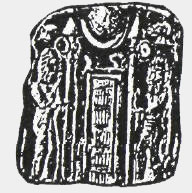
Fig. 56
In one instance the
ancient artist may have intended to illustrate the scene
described in the Uruk ritual text—depicting Enlil and
Enki flanking a gateway through which Anu is
making a grand entrance.
The two gods are holding
posts to which viewing devices (circular instruments
with a hole in the center) are attached (which is in
accord with the text that spoke of Sun disks in the
plural); the Sun and Moon symbols are shown above the
gateway (Fig. 57)
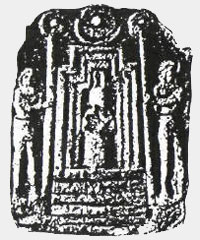
Fig. 57
From "When Time Began" by
Z.Sitchin
pages 112-114 |
The two guards (transformed into thieves in the New Testament) hold
devices, long poles with circular tops, which Sitchin concludes
served an astronomical purpose. He also equates them with golden
pillars at the entrance to Solomon’s Temple.28
This being so, can we see these devices as “golden needles”? Is the
story of this golden needle woven deep into the story of
Jesus’
cruci-fiction? Is the ‘silver thread’ woven by this needle the
wormhole linking Earth with Heaven?
By this rendering, Jesus’ agony in the garden may not be a physical
mutilation. Instead, it would mean soul travel to an otherworldly
locality, Tula. Mary Magdalene’s painful tears in the ‘cave‘ or
‘tomb’ for her daredevil Savior would have actually taken place
inside that marvelous cave in the wilderness -- the Great Pyramid.
SARAPIS
Sarapis holds a vital key to further revealing secrets of the
Stau-Ros pillar. He was a god created in Alexandria, Egypt shortly
after 300 BC, from two existing Greek and Egyptian gods. His purpose
was to symbolize the synthesis of the two cultures that the new
Greek rulers of Egypt hoped would occur.
The name Sarapis, says Higgins, comes from Soros or
S-Ros the name
given by the Egyptians to a (s)tone coffin, and Apis or Opis, the
name given to Osiris (which, as we have already seen, is associated
with the soul).29 These two words combined result in Soro-Apis or
Sor-Apis, ‘the tomb of the bull’ or ‘the tomb of the soul’.
The mysteries of Sarapis explains why the Egyptians would worship a
(s)tone or a coffin in the form of a man, and why Henry Wallace was
awaiting a sacred casket. The word Stau-ros is not only the
mirror-image of Ros-tau, the name of the Giza plateau, but is also
an word play for Tauros or Taurus, the Bull.
In Hebrew, Sarapis is Saraph, meaning ‘to blaze out’ or ‘to blaze
up’. As we have seen, the Seraphim class of angels --the
flying-serpent healers -- derive their name from this word. It also
reminds us of Chiram, and Chamir or Shamir, the ‘worm’ (serpent-soul)
which blazed through the (s)tones used to construct Solomon’s
Temple.
Among the other meanings suggested for the word Sarapis are: ‘The
Soul of Osiris’ and ‘The Sacred Serpent’. In fact, the most common
theory regarding the origin of Sarapis is that it is a compound of
Osiris and Apis.
There once stood a statue of Sarapis in the famed Sarapeum of
Alexandria. The Sarapeum was regarded as one of the wonders of the
ancient world. It was named after an earlier famous Sarapeum which
once stood in Memphis and which contained a library with over
300,000 volumes. Within the temple was an emerald (s)tatue of
Serapis. He was usually shown robed head to foot in heavy draperies.
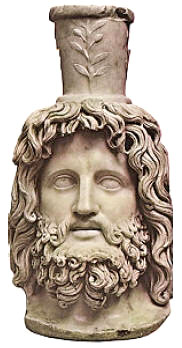
Sarapis
Underneath the temple of Sarapis destroyed by the Romans was a
labyrinth. There, says Manly P. Hall,
“were found strange mechanical
contrivances by the priests in the subterranean crypts and caverns
where the nocturnal
initiatory rites were celebrated.”30
After passing through the
ordeals presented by these machines, the initiates found themselves
face to face with Sarapis.
What were these strange “mechanical contrivances?” Could one of them
have been the Pillar of Osiris, the Tulis or Tula Cross upon which
Higgins says Sarapis was crucified?
If it was the True Cross, we know it was not destined to stay there.
It had an appointment with destiny in Jerusalem c. 30 AD for the
crucifixion of Jesus. The Cross (aka the symbol of AMOR), or its
instruction manual, was then destined to journey to Southern France
to Cathar country where a bridge to Heaven or AMOR was soon to be
built. Before heading to France, however, this device appears to
have been transported to Rome.
MITHRAS AND THE DOOR OF WISDOM
In Rome the mysteries of the bull were celebrated in March and
featured Mithras in the act of killing the bull, the life-force of
the Earth that he himself embodied. We have already associated
Mithras with Maitreya. Mithras is also often equated with
Attis, a
fourth-century BC Greek figure who was known as a good shepherd and
was called the ‘Green Man’ or the ‘Green One,’ and obvious link with
Osiris and Tula.31
He was depicted with sun-rays or ears of corn
emerging from his cap. In rituals he was called ‘the corn-stalk’.32
The Roman rites of his mother Cybele (or Sa-Ba-El) were accompanied
by the sacrifice of a bull in a ritual known as the Taurobolium.33
The cult of Attis strongly influenced early Christianity. He, along
with his mother Nana, were established in a temple on the Vatican
hill in 204 BC, where they remained popular until 900 AD.
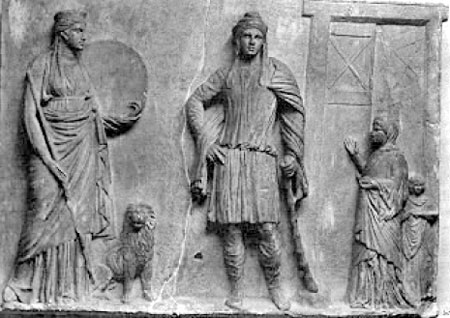
Attis in front of the doors of wisdom.
Followers of Attis (or A-Tet-Is) celebrated his passion on the 25th
of March exactly nine months before the celebration of his birth on
December 25. To mark the moment when Attis entered his mother at
conception, his 60-foot tall tree-phallus was carried into her
sacred cave.34
His death was celebrated as the Day of Blood. Attis died and was
buried. After a journey to the underworld, he was resurrected from
the dead three days later. His worshippers were promised salvation as
a result. The celebration of Attis’ death and resurrection included
the gelded bull of the Taurobolium. At the celebration reed-bearers
carried phallic-shaped scepters representing the regenerated phalli
of the god.
The bull and tree of the Taurobolium are, of course, the TET or
Pillar of Osiris, the 40 foot tall golden device which housed his
soul. As our investigation into the mysteries of the Grail has
revealed, it is probably the same as the (s)tone or coffin of
Sarapis and the Holy Grail, the container of the ‘blood’ or ‘soul’
of Christ.
Inscriptions from the 4th century proclaimed Attis the Menotyrannus,
from Greek tyrannos, “lord,” and Men or Mennu, Osiris as the
resurrected moon-bull.35 From our point of view, he is also the lord
of the Nu or the A~tomic Christ.
THE TAU
The Stau-ros ties a Gordian knot between the Pillar of Osiris, the
Cross of Christ, the Tau, the Cross of the Druids, and the Tau of
the Chinese H-Siens. This is such an extraordinary meeting of the
worlds that it is worthy of some explanation.
Long before the Greeks, and hundreds of years before Jesus, the tau
was adopted by the Druids, the ‘men of the Oak Trees’, who came from
Hyperboria, the Greek name for Heaven. At the center of Hyperboria
was Tula.
The Druids were well known as wise men to the Roman philosophers. As
we have noted, scholars have long debated the origin of the word
‘Druid’. Larousse’s World Mythology says it came from daru-vid,
meaning ’skilled’.
One art in which the Druids were highly skilled was the manufacture
of Tau crosses made of oak trees -- the symbolic Tree of Life
--stripped of their branches. Upon the right branch they cut in the
bark the word Hesus, upon the middle or upright stem the word
Taramis, and on the right Belenus. Over this, above the going off
arms, they cut the name of God, Thau or Tau. This configuration
matches that of the Crucifixion with Jesus accompanied by two
thieves and God above. However, it was in use hundreds of years
before Jesus.
In northern Israel the Druid name Hesus or Jesus was the same as
Ieud or Jeud, the “only begotten son” who was dressed in a royal
robe and sacrificed. Greek versions of this name were Jason and
Iasus, signfiying a healer or therapeutae, a physician of the soul.
This matches the story of Jesus who was an Essene therapeutate from
the royal House of David and his alleged twin, Tammuz or Thomas.
Third century classical scholar, Diogenes Laertius, said the Druids
were the cult of the Magi, the sect of the Three Wise Men who sought
out the Christ child Jesus. It was Druid prophecy that predicted the
arrival of Jesus. Therefore, it would make perfect sense why they
sought the blessed child.
Druid or Daru-vid is, as we have seen, not that far from David.
Rennes-le-Chateau researcher, and expert in the Language of the
Birds, Elizabeth van Buren states the true meaning of David is the
same as the Welsh Duw or Duvydd.36 It means God’s messenger.
This is a fascinating enlargement of our search for the meaning of
the word Druid. God’s messenger is usually depicted as a dove, like
the Dove of the Holy Spirit which flew into Jesus’ mouth at his
baptism by John the Baptist in the River Jordan.37 ‘Dove’ (or ‘Duv’,
which is but Duw) comes from Oannes, the Babylonian name for
E.A,
the serpent-soul of Sumerian mythology who lived in the Pillar.
The Celtic and Latin word for Dove is colomen, colombe, columba. One
excellent example of this name is Christopher Colombus, which means
‘Christ-bearing Dove’. According to Higgins, the I column or pillar
was used by the Druid priests, who were known as ‘the Instructors’,
to signify the sacred island where the I-Pillar(s) were set up as
witnesses to covenants of Peace.38 Oannes, the serpentsoul bird-man,
lived within this Pillar.
David or Dovydd, with the ‘D’s’ at either end of the name, says Ms.
van Buren, also represents Dol or door, that is, a pillar, tower or
column reaching to Heaven. In Hebrew, she notes, dohv means bear,
which phonetically is the same as bier or coffin.
39
THE TOWER
Some researchers maintain the Druids are named after the Celtic word
for “oak,” or duir, phonetically door. In Welsh, which is closely
related to old Celtic, derw is “oak,” drws is “door“ and dwr is
“water.” Fascinatingly, the Pillar of Osiris was also known as the
tawer of Osiris. Tawer is an anagram for Water. The letters ‘t’ and
the ‘d’ are interchangeable. When we remove the vowels and allow for
this interchange the Celtic drw, oak, becomes trw. Likewise, the
Druid dwr or water becomes twr, which with the addition of an ‘a’ or
‘o’ becomes tawer and tower.
These word plays suggest that, once again, the Tawer or Tower of
Osiris, also known as the Pillar of Osiris, is the same as the
Pillar of David and possibly the Tower of Babel. This Pillar, of
course, was installed in Solomon’s Temple in c. 1,000 B.C.
Had it been returned to the rebuilt Second Temple of Solomon at the
time of the Crucifixion of Jesus?
Interestingly, the Hebrew root Dud means ‘love, that which unites
together’, an apt description of the Stau-ros Pillar.40 Dud, Duw or
Dovydd is also the dew of the alchemists, the elixir of immortality.
In many myths the revelation of the dew (love) is brought by the
Morning Star, an epithet for Jesus who was of the Royal House of
David.
From our investigation we can see that the term “Royal House of
David” may mean either the House of the Dove, the House of the
Pillar or the House of the Dew. Its function is to produce the
elixir of immortality, the nuclear mother substance. This is
precisely what the Bible claims Jesus did at his Crucifixion. This
mother substance is the Blue Apples.
SPLITTING THE VEIL
In addition to Jesus’ apparent production of this nuclear mother
substance, Matthew’s Gospel records two effects of the activity
involving the Stau-Ros Pillar at the Crucifixion.
The first effect was an earthquake.
The second effect was a ‘veil’ within the Holy of Holies of the
Temple of Solomon was split in half revealing God’s presence.41 The
Holy of Holies housed the Ark of the Covenant. It was entered on
only one day of the year: the Day of Atonement. The veil was not
split on any other day.
According to the Book of Exodus,42 this veil was made of blue,
purple and scarlet linen. It was made with (or by) angels and it
hung from four pillars of wood overlaid with gold. It simultaneously
shielded and connected the High Priest with God.
This veil is known as the veil or gate revealed by the Apocalypse
(Greek for ‘uncovering’, from the root apo, far away, and kalyptein,
to uncover) 43 in the book of Revelation.
When we view these word fossils as a whole it seems Jesus had a
powerful linguistic connection with the ancient Druids and some kind
of apocalyptic Pillar which split open a gate to God, creating a
moment of Peace in which God was revealed from ‘far away’.
Joseph of Arimathea’s request for the soma, the blood of life (or
wisdom of the blood of life) suggests a link with the Greek
mysteries and the Hindu mysteries of which the Druids were masters.
He appears to be asking for the mother substance from the Stau-ros,
the Druid Pillar of Wisdom that opens a water door that connect
Heaven and Earth via wormhole. This secret may not be the body of
Jesus, but something -- the definition of soma suggests either blood
or a wise soul -- which came from within it.
In fact, Christ crowned with (t)horns is sometimes depicted casting
rays of Christ Light (like the symbolic horns of Moses). As noted,
the word crucifixion comes from crux or crucis, a cross, and
figere,
to fasten.
Not only was the Son, Jesus, fastened or connected to a pillar
(through the crown), but also the process of Crucifixion fastened,
fused or connected him to a higher or inner source of Light. This is
symbolized in Christian art by a halo of sunlight around his head.
This Christ Light was pulled from ‘far in the universe’ and
‘crucified’ by Jesus.
In absence of the ability to directly study this actual Pillar of
Wisdom, we are left with continuing to follow the stories of those
who were connected with its Light. I have looked at the stories of
Osiris, E.A, and Mari.
Another person we can turn to is Jesus’ uncle, Joseph of Arimathea,
one of the greatest figures of mystery in the story of Jesus. His
request for the secret mother substance may also explain why the
Gospels offer so few details concerning him. The writers probably
assumed we would know, or would look up, or split open, the meaning
of the term soma and would have connected him with the proper
nuclear Druidic, Hindu, Sumerian, Greek and Egyptian traditions.
Back to
Contents
|






